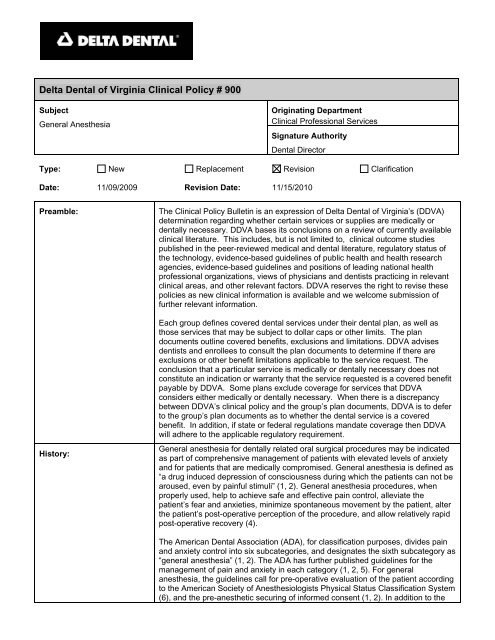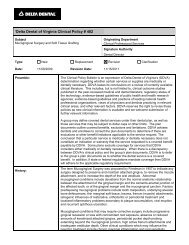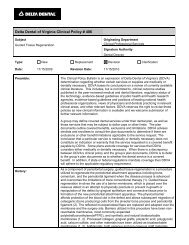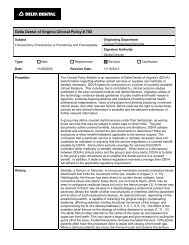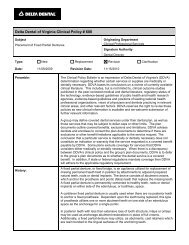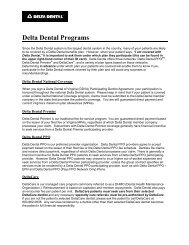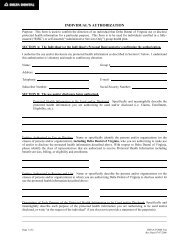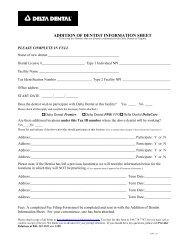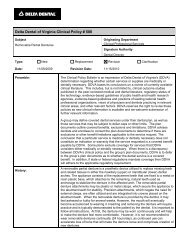900 General Anesthesia - Delta Dental of Virginia
900 General Anesthesia - Delta Dental of Virginia
900 General Anesthesia - Delta Dental of Virginia
You also want an ePaper? Increase the reach of your titles
YUMPU automatically turns print PDFs into web optimized ePapers that Google loves.
<strong>Delta</strong> <strong>Dental</strong> <strong>of</strong> <strong>Virginia</strong> Clinical Policy # <strong>900</strong><br />
Subject<br />
<strong>General</strong> <strong>Anesthesia</strong><br />
Originating Department<br />
Clinical Pr<strong>of</strong>essional Services<br />
Signature Authority<br />
<strong>Dental</strong> Director<br />
Type: New Replacement Revision Clarification<br />
Date: 11/09/2009 Revision Date: 11/15/2010<br />
Preamble:<br />
History:<br />
The Clinical Policy Bulletin is an expression <strong>of</strong> <strong>Delta</strong> <strong>Dental</strong> <strong>of</strong> <strong>Virginia</strong>’s (DDVA)<br />
determination regarding whether certain services or supplies are medically or<br />
dentally necessary. DDVA bases its conclusions on a review <strong>of</strong> currently available<br />
clinical literature. This includes, but is not limited to, clinical outcome studies<br />
published in the peer-reviewed medical and dental literature, regulatory status <strong>of</strong><br />
the technology, evidence-based guidelines <strong>of</strong> public health and health research<br />
agencies, evidence-based guidelines and positions <strong>of</strong> leading national health<br />
pr<strong>of</strong>essional organizations, views <strong>of</strong> physicians and dentists practicing in relevant<br />
clinical areas, and other relevant factors. DDVA reserves the right to revise these<br />
policies as new clinical information is available and we welcome submission <strong>of</strong><br />
further relevant information.<br />
Each group defines covered dental services under their dental plan, as well as<br />
those services that may be subject to dollar caps or other limits. The plan<br />
documents outline covered benefits, exclusions and limitations. DDVA advises<br />
dentists and enrollees to consult the plan documents to determine if there are<br />
exclusions or other benefit limitations applicable to the service request. The<br />
conclusion that a particular service is medically or dentally necessary does not<br />
constitute an indication or warranty that the service requested is a covered benefit<br />
payable by DDVA. Some plans exclude coverage for services that DDVA<br />
considers either medically or dentally necessary. When there is a discrepancy<br />
between DDVA’s clinical policy and the group’s plan documents, DDVA is to defer<br />
to the group’s plan documents as to whether the dental service is a covered<br />
benefit. In addition, if state or federal regulations mandate coverage then DDVA<br />
will adhere to the applicable regulatory requirement.<br />
<strong>General</strong> anesthesia for dentally related oral surgical procedures may be indicated<br />
as part <strong>of</strong> comprehensive management <strong>of</strong> patients with elevated levels <strong>of</strong> anxiety<br />
and for patients that are medically compromised. <strong>General</strong> anesthesia is defined as<br />
“a drug induced depression <strong>of</strong> consciousness during which the patients can not be<br />
aroused, even by painful stimuli” (1, 2). <strong>General</strong> anesthesia procedures, when<br />
properly used, help to achieve safe and effective pain control, alleviate the<br />
patient’s fear and anxieties, minimize spontaneous movement by the patient, alter<br />
the patient’s post-operative perception <strong>of</strong> the procedure, and allow relatively rapid<br />
post-operative recovery (4).<br />
The American <strong>Dental</strong> Association (ADA), for classification purposes, divides pain<br />
and anxiety control into six subcategories, and designates the sixth subcategory as<br />
“general anesthesia” (1, 2). The ADA has further published guidelines for the<br />
management <strong>of</strong> pain and anxiety in each category (1, 2, 5). For general<br />
anesthesia, the guidelines call for pre-operative evaluation <strong>of</strong> the patient according<br />
to the American Society <strong>of</strong> Anesthesiologists Physical Status Classification System<br />
(6), and the pre-anesthetic securing <strong>of</strong> informed consent (1, 2). In addition to the
surgeon, the presence <strong>of</strong> a minimum <strong>of</strong> two auxiliary personnel trained in Basic<br />
Life Support (BLS) for Healthcare Providers is recommended. If patients are<br />
intubated for airway maintenance, the recommendations call for use <strong>of</strong> in-line<br />
oxygen analyzers and end-tidal carbon dioxide monitoring. Without intubation,<br />
either end-tidal CO 2 monitoring or precordial stethoscope monitoring <strong>of</strong> the<br />
patient’s respiratory rate is recommended. The ADA recommends body<br />
temperature and vital signs be monitored continuously until the patient meets the<br />
criteria for recovery. Appropriate documentation <strong>of</strong> general anesthesia includes a<br />
time-oriented anesthetic record indicating start and stop time <strong>of</strong> anesthesia and<br />
surgery including the name and dosage <strong>of</strong> all drugs administered, time <strong>of</strong><br />
administration <strong>of</strong> drugs including local anesthetics, as well as monitored and<br />
recorded physiological parameters (1,2).<br />
According to the ADA 2009-2010 CDT code book, “<strong>Anesthesia</strong> time begins when<br />
the doctor administering the anesthetic agent initiates the appropriate anesthesia<br />
and non-invasive monitoring protocol and remains in continuous attendance <strong>of</strong> the<br />
patient. <strong>Anesthesia</strong> services are considered completed when the patient may be<br />
safely left under the observation <strong>of</strong> trained personnel and the doctor may safely<br />
leave the room to attend to other patients or duties. The level <strong>of</strong> anesthesia is<br />
determined by the anesthesia provider’s documentation <strong>of</strong> the anesthetic’s effects<br />
upon the central nervous system and not dependent upon the route <strong>of</strong><br />
administration.”<br />
The American Association <strong>of</strong> Oral and Maxill<strong>of</strong>acial Surgeons (AAOMS) has<br />
divided guidelines for anesthesia into three categories, with category three being<br />
deep sedation/general anesthesia (4). The AAOMS has established four criteria for<br />
determination <strong>of</strong> general anesthesia: the inability to respond to physical or verbal<br />
stimuli; partial or complete loss <strong>of</strong> protective reflexes; absence <strong>of</strong> pain, anxiety,<br />
awareness, and recall; and the inability to maintain an airway (3,4).<br />
Policy:<br />
The ADA recommends that dentists who administer general anesthesia complete<br />
an advanced education program accredited by the ADA Commission on <strong>Dental</strong><br />
Accreditation. Additionally, dentists should have current certification in Basic Life<br />
Support (BLS) for Healthcare Providers as well as Advanced Cardiac Life Support<br />
(ACLS), or an appropriate sedation and anesthesia emergency management<br />
course (1,5).<br />
DDVA Guidelines:<br />
1. May be achieved by either inhalation or intravenous delivery.<br />
2. Must be administered by a licensed dentist.<br />
3. Will be considered for use in conjunction with surgical procedures<br />
D3351/52/53, 3410/21/25/26/50, 4240/41/49/60/61, and 6010.<br />
4. If deemed necessary due to concurrent medical conditions that exhibit<br />
physical, intellectual or medically compromised conditions, such as mental<br />
retardation, cerebral palsy, epilepsy cardiac conditions and hyperactivity.<br />
Medical conditions which require the need for general anesthesia must be<br />
substantiated by submission <strong>of</strong> a statement <strong>of</strong> necessity from the oral<br />
surgeon or physician administering the anesthesia.<br />
5. The level <strong>of</strong> anesthesia is not determined by the route <strong>of</strong> administration, but<br />
by the dentist’s documentation <strong>of</strong> the anesthetic agent’s effect on the patient’s<br />
central nervous system.
6. The time <strong>of</strong> general anesthesia begins when the dentist starts administering<br />
the anesthetic agent and non-invasive monitoring protocol.<br />
7. The dentist administering the anesthesia must remain in constant attendance<br />
with the patient until completion <strong>of</strong> the anesthesia procedure.<br />
8. Services are considered complete when the patient may be safely left under<br />
the observation <strong>of</strong> trained personnel, and the dentist may safely leave the<br />
operatory to attend to other patients.<br />
9. In excess <strong>of</strong> 60 minutes will require written documentation explaining the<br />
rationale for excessive anesthesia for the surgical service. Necessary<br />
documentation includes all associated X-rays, progress notes and the<br />
complete anesthesia record.<br />
10. <strong>General</strong> anesthesia may be considered for two or more surgical extractions,<br />
or for three <strong>of</strong> more routine extractions on the same date <strong>of</strong> service<br />
dependent upon statement <strong>of</strong> necessity.<br />
11. <strong>General</strong> anesthesia will be considered appropriate for patients five years <strong>of</strong><br />
age or younger.<br />
Code(s):<br />
References:<br />
D9220, D9221 (7)<br />
1. American <strong>Dental</strong> Association. Guidelines for Use <strong>of</strong> Sedation and <strong>General</strong><br />
<strong>Anesthesia</strong> by Dentists. Chicago IL, ADA. Oct 2007.<br />
2. American <strong>Dental</strong> Association. Guidelines for Teaching Pain Control and<br />
Sedation to Dentists and <strong>Dental</strong> Students. Chicago IL, ADA. Oct 2007.<br />
3. Guidelines for Anxiety Control and Pain Management in Oral and Maxill<strong>of</strong>acial<br />
Surgery. Zuniga JR. J Oral Maxill<strong>of</strong>ac Surg 2000; 58(Suppl 2):4-7.<br />
4. Parameters <strong>of</strong> Care for Oral and Maxill<strong>of</strong>acial Surgery. A Guide for Practice,<br />
Monitoring, and Evaluation (AAOMS Parameters <strong>of</strong> Care-(95). J Oral<br />
Maxill<strong>of</strong>ac Surg 1995; 53(Suppl 5):1-29.<br />
5. American <strong>Dental</strong> Association. The Use <strong>of</strong> Sedation and <strong>General</strong> <strong>Anesthesia</strong><br />
by Dentists. Policy Statement. Chicago IL, ADA. Oct 2007.<br />
6. American Society <strong>of</strong> Anesthesiologists, 520 N Northwest Hgwy, Park Ridge<br />
IL.<br />
7. American <strong>Dental</strong> Association. Current <strong>Dental</strong> Terminology. CDT 2011-<br />
2012;73 (©ADA 2010).


